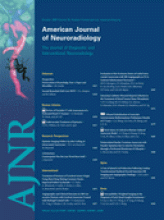Research ArticleBrain
Open Access
Regional White Matter Atrophy−Based Classification of Multiple Sclerosis in Cross-Sectional and Longitudinal Data
M.P. Sampat, A.M. Berger, B.C. Healy, P. Hildenbrand, J. Vass, D.S. Meier, T. Chitnis, H.L. Weiner, R. Bakshi and C.R.G. Guttmann
American Journal of Neuroradiology October 2009, 30 (9) 1731-1739; DOI: https://doi.org/10.3174/ajnr.A1659
M.P. Sampat
A.M. Berger
B.C. Healy
P. Hildenbrand
J. Vass
D.S. Meier
T. Chitnis
H.L. Weiner
R. Bakshi

References
- 1.↵
- Miller DH,
- Barkhof F,
- Frank JA,
- et al
- 2.↵
- Bermel RA,
- Bakshi R
- 3.↵
- Hauser SL,
- Oksenberg JR
- 4.↵
- Owens T
- 5.↵
- Peterson LK,
- Fujinami RS
- 6.↵
- Miller DH,
- Leary SM
- 7.↵
- Ge Y
- 8.↵
- Miller DH
- 9.↵
- Sailer M,
- Fischl B,
- Salat BD,
- et al
- 10.↵
- Bermel RA,
- Bakshi R,
- Tjoa RC,
- et al
- 11.↵
- Houtchens MK,
- Benedict RH,
- Killiany R,
- et al
- 12.↵
- Liptak Z,
- Berger AM,
- Sampat MP,
- et al
- 13.↵
- Pelletier J,
- Suchet JL,
- Witjas T,
- et al
- 14.↵
- Gauthier SA,
- Glanz BI,
- Mandel M,
- et al
- 15.↵
- McDonald WI,
- Compston A,
- Edan G,
- et al
- 16.↵
- Polman CH,
- Reingold SC,
- Edan G,
- et al
- 17.↵
- Lublin FD,
- Reingold SC
- 18.↵
- Wei X,
- Warfield SK,
- Zou KH,
- et al
- 19.↵
- Warfield SK,
- Kaus M,
- Jolesz FA,
- et al
- 20.↵
- Guttmann CR,
- Kikinis R,
- Anderson MC,
- et al
- 21.↵
- Luft AR,
- Skalej M,
- Schulz JB,
- et al
- 22.↵
- Murshed KA,
- Ziylan T,
- Seker TM,
- et al
- 23.↵
- Rashid W,
- Davies GR,
- Chard DT,
- et al
- 24.↵
- Vaithianathar L,
- Tench CR,
- Morgan PS,
- et al
- 25.↵
- Liu C,
- Edwards CS,
- Gong Q,
- et al
- 26.↵
- 27.↵
- Hofer S,
- Frahm J
- 28.↵
- Duda RO,
- Hart PE,
- Stork DG
- 29.↵
- Bieniek M,
- Altmann DR,
- Davies GR,
- et al
- 30.↵
- Losseff NA,
- Webb SL,
- O'Riordan JI,
- et al
- 31.↵
- Filippi M,
- Campi MA,
- Colombo B,
- et al
- 32.↵
- Tench CR,
- Morgan PS,
- Jaspan T,
- et al
- 33.↵
- Stevenson VL,
- Leary SM,
- Losseff NA,
- et al
- 34.↵
- Kidd D,
- Thorpe JW,
- Thompson AJ,
- et al
- 35.↵
- Simon JH,
- Jacobs LD,
- Campion MK,
- et al
- 36.↵
- Audoin B,
- Ibarrola D,
- Malikova I,
- et al
- 37.↵
- Martola J,
- Stawiarz JL,
- Fredrikson S,
- et al
- 38.↵
- Evangelou N,
- Esiri MM,
- Smith S,
- et al
- 39.↵
- Witelson SF
- 40.↵
- Jokinen H,
- Ryberg C,
- Kalska H,
- et al
- 41.↵
- Huijbregts SC,
- Kalkers NF,
- de Sonneville LM,
- et al
- 42.↵
- Foong J,
- Rozewicz L,
- Chong WK,
- et al
- 43.↵
- Comi G,
- Filippi M,
- Martinelli V,
- et al
- 44.↵
- Oh J,
- Pelletier D,
- Nelson SJ
- 45.↵
- DeLuca GC,
- Ebers GC,
- Esiri MM
- 46.↵
- Gilmore CP,
- DeLuca GC,
- Bo L,
- et al
- 47.↵
- Ann Marrie R,
- Rudick RA
- 48.↵
- Evangelou N,
- Konz D,
- Esiri MM,
- et al
- 49.↵
- Ciccarelli O,
- Werring DJ,
- Barker GJ,
- et al
- 50.↵
- Coombs BD,
- Best A,
- Brown MS,
- et al
- 51.↵
- 52.↵
- Lin X,
- Tench CR,
- Morgan PS,
- et al
- 53.↵
- Mesaros S,
- Rocca MA,
- Riccitelli G,
- et al
- 54.↵
- Raininko R,
- Autti T,
- Vanhanen SL,
- et al
- 55.↵
- Mitchell TN,
- Free SL,
- Merschhemke M,
- et al
- 56.↵
- Sullivan EV,
- Rosenbloom MJ,
- Desmond JE,
- et al
In this issue
Advertisement
M.P. Sampat, A.M. Berger, B.C. Healy, P. Hildenbrand, J. Vass, D.S. Meier, T. Chitnis, H.L. Weiner, R. Bakshi, C.R.G. Guttmann
Regional White Matter Atrophy−Based Classification of Multiple Sclerosis in Cross-Sectional and Longitudinal Data
American Journal of Neuroradiology Oct 2009, 30 (9) 1731-1739; DOI: 10.3174/ajnr.A1659
0 Responses
Regional White Matter Atrophy−Based Classification of Multiple Sclerosis in Cross-Sectional and Longitudinal Data
M.P. Sampat, A.M. Berger, B.C. Healy, P. Hildenbrand, J. Vass, D.S. Meier, T. Chitnis, H.L. Weiner, R. Bakshi, C.R.G. Guttmann
American Journal of Neuroradiology Oct 2009, 30 (9) 1731-1739; DOI: 10.3174/ajnr.A1659
Jump to section
Related Articles
- No related articles found.
Cited By...
- No citing articles found.
This article has not yet been cited by articles in journals that are participating in Crossref Cited-by Linking.
More in this TOC Section
Similar Articles
Advertisement











